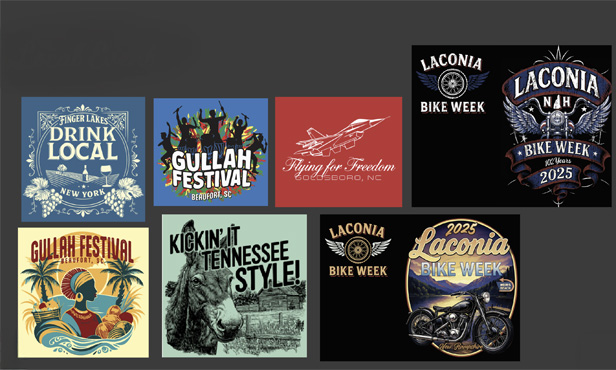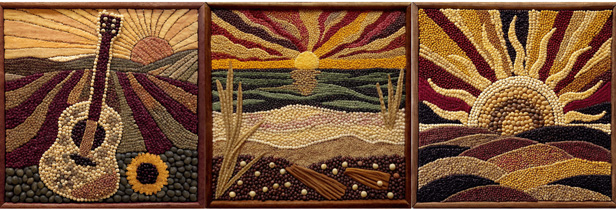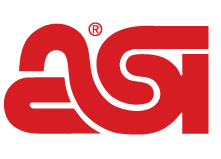Strategy August 18, 2025
Art in the Age of Algorithms: The Promise & Pitfalls of AI Design
Though fewer than a quarter of promo pros are using generative AI for artwork or video generation, expect that number to grow as deep learning models become more sophisticated. Still, many warn against the technology’s practical limitations and ethical issues.
Key Takeaways
• Generative AI is increasingly being used in the promotional products industry, with 24% of suppliers and 19% of distributors employing it for artwork or video generation, primarily to speed up design processes, create mock-ups and support brainstorming.
• AI art generators can significantly increase output and handle complex styles quickly, but they struggle with text accuracy, realistic embroidery design and the nuanced, emotional elements of high-profile logo creation.
• Experts cite potential job losses, high energy consumption and copyright risks as key concerns, prompting calls for transparency and thoughtful integration of AI into creative workflows.
Glowing geometric puzzle pieces fit together perfectly behind company logos. Moss-green Floridian foliage is the backdrop for swooping letters advertising a family festival. A grinning raccoon palms a frothy beer next to a witty catchphrase.
Few people would guess the graphics were created with the help of generative AI.
Decorated apparel industry veteran Marshall Atkinson helmed their creation, in part, using Midjourney, an AI model that specializes in images. He says AI-generated artwork cuts down his design time and can replace up to 80% of the creative process.
“Why would I spend three hours doing something when I can spend 20 minutes?” he asks.

Atkinson used generative AI to create the foundation of these designs, then fine-tuned them, adding color, text and logos to create the final product.
While Atkinson says he still goes in manually to add elements like text, color and company-specific designs, he’s part of the growing number of designers using AI artwork for logo creation, brainstorming or other avenues that streamline the creative process.
According to the 2025 State of the Industry report, 24% of suppliers and 19% of distributors use AI for artwork or video generation — the second-most common reason to use the technology for suppliers and third-most common for distributors.
Generative AI can be a powerful tool to help save time and money – especially for promo companies with smaller staff or tighter budgets, experts say. However, some industry professionals are more cautious about the technology, citing copyright concerns and shifting consumer expectations.
“I honestly think the best way [industry professionals] can use AI is not to use it for art generation,” says veteran embroidery digitizer and designer Erich Campbell. “There’s a lot of uses that don’t have to impinge on the one creative thing we’re doing that could still be quite helpful and save money and save time.”
AI’s Promo Potential
One of the biggest benefits of incorporating AI into art creation is the speed with which designers can iterate new ideas and create mock-up designs, proponents say. For instance, last week, freelance artist Michelle Moxley used AI to create 60 T-shirt graphics in two days. It’s a striking productivity gain compared to traditional methods: Relying primarily on clip art, Moxley says, she could make three to five graphics per day; with hand-drawn sketches, that number drops to one to three.
“AI enables me to provide a greater variety of options and refresh them more frequently, which increases overall value,” she adds.
Moxley notes, however, that she treats AI like a “custom clip art machine,” creating graphics under different generators and then cutting them out and putting them together.
“It’s a little bit of a collage effect,” she says. “It’s not like I go and just generate a design and then take it. I take pieces.”

Moxley created these T-shirts with help from AI, which allowed her to root the designs in real locations.
In addition to ramping up the volume of artwork creation, a properly trained AI model can take on complex tasks with lightning-fast speed, says Moxley. She trained an AI model to replicate seed art, a technique for creating intricate, mosaic-style designs with seeds.
“You can make a piece of seed art, but can you make 25?” Moxley says. “That would take me two years. This took me, once I trained it, 20 minutes.”

Moxley trained an AI model by feeding it specific data to create artwork that mimics a seed-art technique.
AI tools are also being used to support print-on-demand production. NJ-based supplier Unionwear (asi/73775) recently worked with the New Jersey Institute of Technology to develop an AI-powered pattern generator for the company’s tote bags. Customers can choose from hundreds of pre-generated options, edit an existing AI prompt or write their own to create unique designs. They can also upload an existing pattern – perhaps printed on a T-shirt – to create a matching bag, according to Unionwear President Mitch Cahn.
“First, what we’re going to do is give clients hundreds of designs to pick from. Then we’re going to make it easy for them to edit those designs so they can tweak it into other colors or other patterns, and then we’re going to make it easy for them to just do whatever kind of designs they want,” Cahn says, explaining the thought process behind the project. “The next phase would be to help guide people with educating them on how to come up with the best prompts.”
The Limitations of AI-Generated Art
In the last few years, AI models like Midjourney and OpenAI’s Dall-E have grown increasingly sophisticated because neural network algorithms allow them to keep learning from large datasets of images and generate more realistic artwork, according to the Interactive Design Foundation.
But AI still has limitations when it comes to spelling or replicating fonts, designers say. Moxley’s podcast, Fahrenheit AI, which explores AI applications for creative professionals, got its name because only Ideogram, an AI image generator created by former Google Brain researchers, could spell "Fahrenheit" correctly. Atkinson adds that he never relies on AI for text because he’s particular about fonts.
In the embroidery sector, AI-generated artwork, for now, isn’t a major player, according to Campbell. While some companies use splashy language to describe AI-powered digitizing, it’s typically a buzzword advertising the same auto-digitizing process that’s been around for years, he says.
AI-generated images meant to recreate the embroidered look may seem promising, but are often composed of impossibly small stitches that would be unrealistic to render in thread, he adds.
“We still don’t have an automatic way to take a piece of art you give us and spit out good-quality embroidery,” Campbell says.
Even with its advancements, AI isn’t a realistic replacement for logo design, particularly for multimillion-dollar corporations with a high-profile image, says Vladimir Gendelman, CEO of Company Folders (asi/287795).
“When you design a logo, you have to consider emotional aspects, the human touch points,” he adds. “AI doesn’t do that.”
Ethics of AI-Generated Artwork
In the August 2025 issue of Vogue, a smiling blonde model with white teeth, light eyes and smooth skin was the face of a Guess ad. She looked too perfect to be real – because she wasn’t. After the brand confirmed the model was AI-generated, readers flooded the fashion magazine with criticism. Among the complaints? Using AI-generated images promotes unattainable beauty standards and takes work away from human photographers and models.
Designers and artists are already feeling the pinch of dwindling job opportunities, Campbell says, because AI-generated artwork is so easy to produce and costs less than hiring an artist.
“All my friends who are digital artists, people who live on commissions, are suffering,” he says. “That’s just the honest truth.”
There will always be opportunities for highly skilled craftspeople, he adds, but middle-of-the-road jobs, vectorizing a standing logo or basic image cleanup may not be as feasible as they once were.
Another frequent criticism of AI artwork is its high environmental impact. Generating a standard-quality image with the leading open-source image generator, considering all the energy it takes to run a computer, requires about 2,282 joules of graphic processing units. Just slightly improving the image quality would increase it to an estimated 4,402 joules – the equivalent of riding 250 feet on an e-bike or running a microwave for about five and a half seconds, according to MIT Technology Review. Consider how quickly and easily users can create new images with AI, and it’s easy to see the staggering energy costs of the technology. By 2028, experts have speculated that more than half of the electricity going to data centers will be used for AI – with AI using as much electricity annually as 22% of all U.S. households, according to the same MIT article.
Another major mainstream criticism of AI-generated artwork is copyright infringement, with many authors, artists and corporations arguing that large language models are producing copyrighted images based on the material on which they’ve been trained. In recent years, dozens of copyright lawsuits have popped up from companies like The New York Times, Universal Music Group and individuals, including authors Sarah Silverman and Ta Nehisi-Coates.
“People were ripping off Mickey Mouse long before AI. When photography started, all the portrait painters suddenly said, ‘Art is dead.’ Did art die because photography was invented? No. Is art going to die because AI was invented? No.” – Marshall Atkinson
That’s part of the reason Moxley is transparent about when she uses AI. She’s worked with some clients who are curious about the potential for integrating the technology and others who are resistant.
“Do I think that AI is stealing? Yeah, I do,” she says. “I don’t know how I feel about it, because in some ways, there should be regulations, but other things, I just don’t know.”
Atkinson, who also runs a newsletter and website guiding creative professionals through AI, says he uses the technology as a tool – not as a way to copy others’ work — and always adds his own touch to designs by manually changing elements. An AI model trained on data and learning what the color blue is, how a horse looks or the intricacies of a sunset is no different than a student recreating artwork at a museum by studying its composition and structure, he says.
“People were ripping off Mickey Mouse long before AI,” he says. “When photography started, all the portrait painters suddenly said, ‘Art is dead.’ Did art die because photography was invented? No. Is art going to die because AI was invented? No.”
